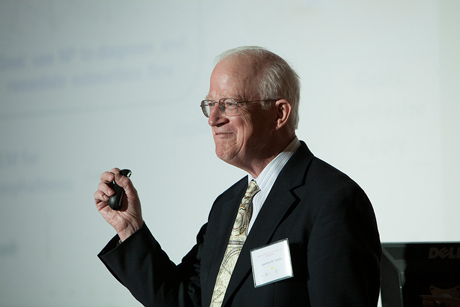Larry Cathles offers remedies for Earth's eco future
By Blaine Friedlander

With ecological viability threatened, world resources draining, population burgeoning and despair running rampant, the end is nigh.
Or not, says Lawrence M. Cathles, Cornell professor of earth and atmospheric sciences. “In spite of our apparent environmental problems, we stand a remarkable chance of achieving solutions. Societies all around the world are living longer. We have more access to food, clean water and energy … and we’ve never been more healthy,” he says.
Under his scientific eye for examining problems and addressing solutions, Cathles is optimistic about the world’s prospects for sustaining the human population in an environmentally responsible way in his article, “Future Rx: Optimism, Preparation, Acceptance of Risk,” in Geological Society of London Special Publication No. 393, “Ore Deposits in an Evolving Earth,” on Oct. 23.
“If we have the courage to do big things, all of humanity has a fine future,” says Cathles in the article, which addresses food sustainability, natural resources and energy levels, and what he calls the “Grand Challenge” of the next century for everyone to achieve a European standard of living. In his paper, Cathles asks whether the Grand Challenge can be met in an environmentally satisfactory way, and then he proposes a path to its achievement.
Achieving European standard
Today the world hosts 7.13 billion people. In sub-Saharan Africa, life expectancy went from 35 years in 1950 to 48 in 2010 and is expected to rise to 65 by 2050. The average Chinese person in 1930 lived to age 24 but now lives to 70. Humans are living longer, but the world population will peak at 10.5 billion about 100 years from now, he says.
The most essential resource is energy, and today most of the world uses less than 2 kilowatts of power per person (for heat, lighting, transportation and manufacturing), while those at the European standard of living (the average Frenchman or German, for example) use 3.5 times more. The world currently consumes energy at the rate of 15 trillion watts (15 terawatts), with 86 percent from hydrocarbon sources.
Meeting the Grand Challenge would require energy production of 50 terawatts today and 75 terawatts 100 years hence, ideally all from zero carbon energy sources, says Cathles. Growing from 15 to 75 terawatts over a century requires a growth rate of 1.6 percent per year, which is modest compared with the U.S. growth rate of 2.6 percent over the past 50 years and China’s recent 12 percent growth rate and their planned growth over the next 10 years of 7 percent annually.
The lion’s share of the power expansion could be met by wind, solar power produced in deserts or nuclear, but by far the least environmentally intrusive, feasible and realistic option is nuclear, he says. The oceans have enough dissolved uranium to sustain 10.5 billion people at a European standard for more than 100 centuries, and the extraction footprint would be tiny. Calculations by Cathles do not count thorium fuels or contributions to energy from wind or solar tides. And long before 100 centuries is up, humanity will have other, even better sources such as fusion, he says.
With the foundational energy supply assured – “everything is possible with energy, nothing is possible without it,” says Cathles – the paper quantitatively examines whether the supplies of other materials are adequate to sustain 10.5 billion people for hundreds of centuries and sees no major sustainability problems.
Energy and resources
The seafloor holds sufficient resources of copper (needed for advanced turbines) and zinc; there is enough lithium dissolved in the oceans to supply every one of 10.5 billion people with one-fourth of an electric car, he says; rare earth elements are abundant in seafloor sediments; and phosphate resources in the oceans are adequate to sustain the needed agricultural production for thousands of centuries.
Cathles shows how natural gas provides a natural transition from dependence on fossil fuels to carbon-free nuclear and other energy sources, and he points out that this transition will occur with manageable greenhouse warming, and that the transition cannot be stretched out too much due to oil and gas resource limitations. Our most threatened resource may be soil, he says, but with energy this will not be a fundamental barrier to prosperity.
Embracing the challenge of a European standard a century from now is “the most constructive goal imaginable,” he says, and one that is necessary for humans to have a future and, more importantly, a common future.
With optimism, preparation (getting ready to harvest minerals from the oceans) and acceptance of risk, humanity will have a fine future, and the future – in all regards – will continue to be better than in the past.
Says Cathles: “We have plenty of resources; we do not need to fight over them.”
The full manuscript can be downloaded free online.
Media Contact
Get Cornell news delivered right to your inbox.
Subscribe